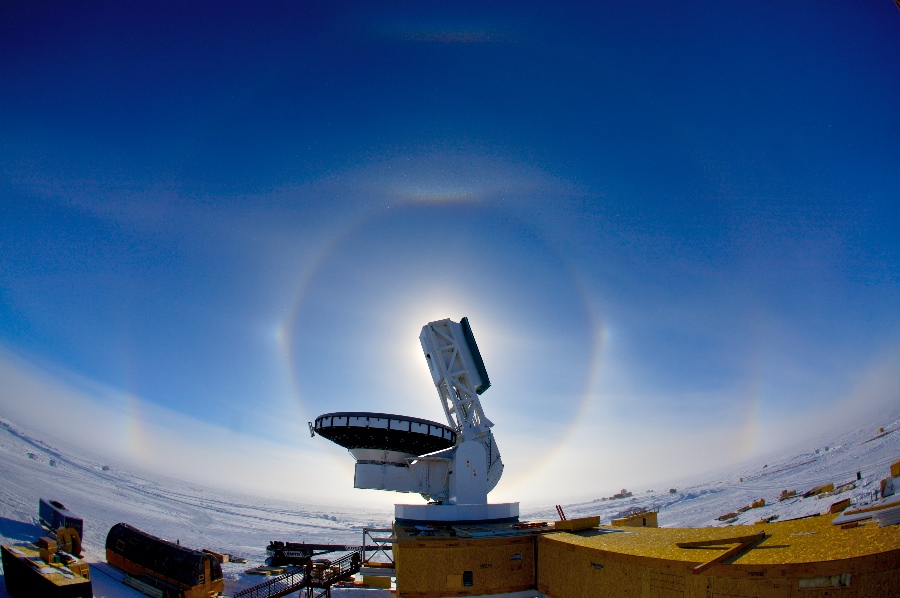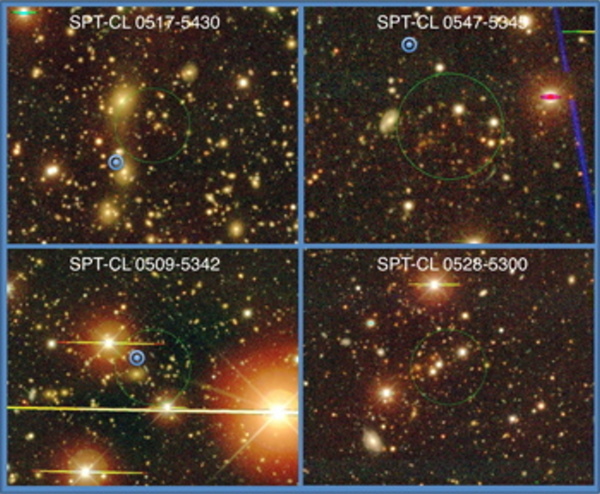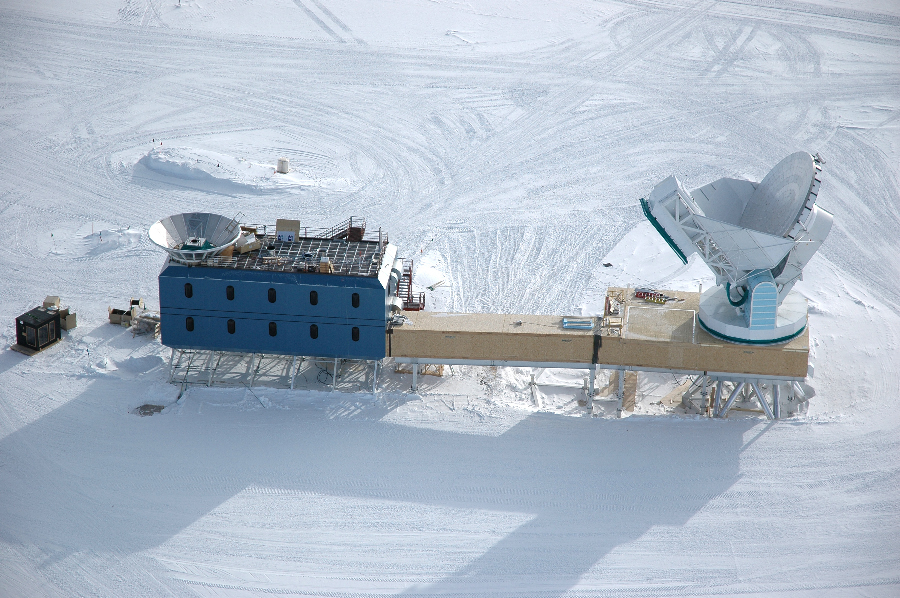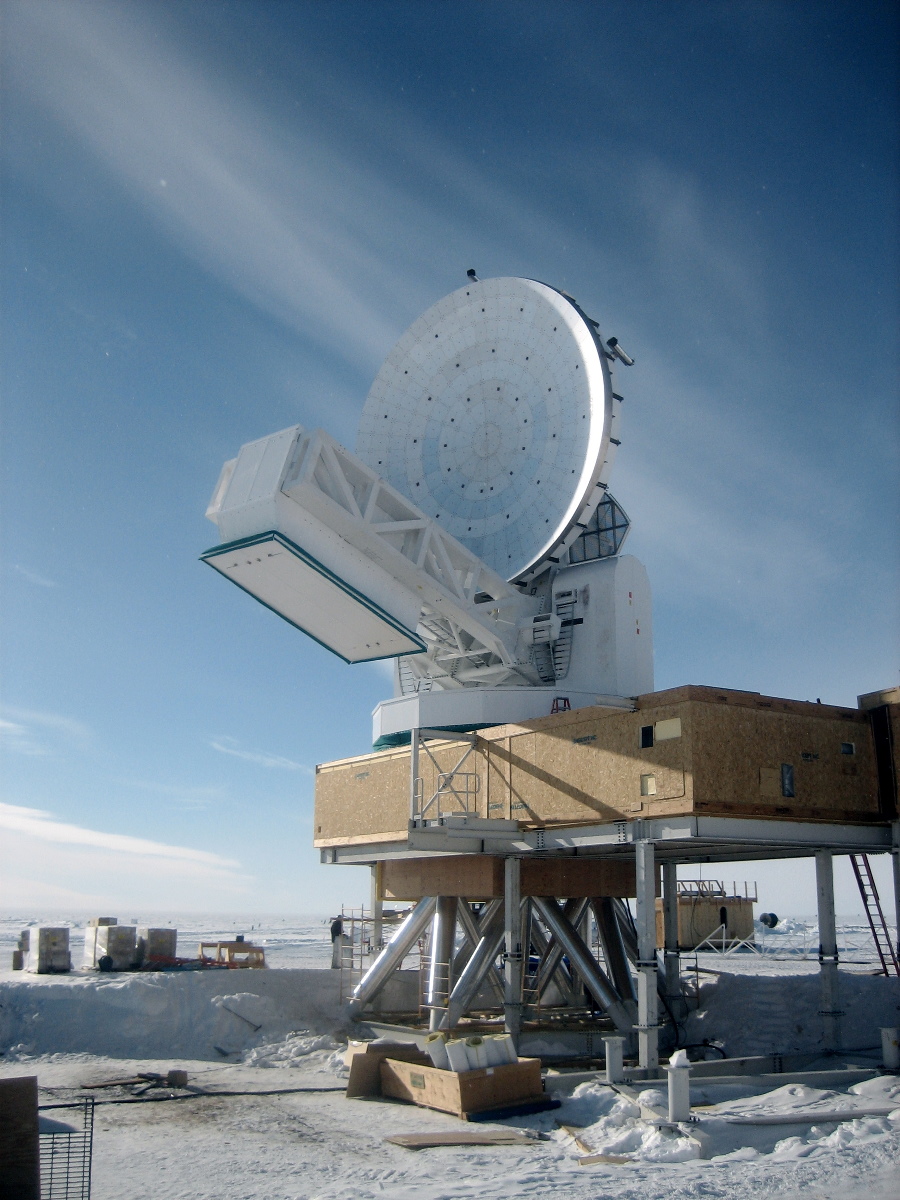|
|
|
|
....
Backlit South Pole Telescope in profile, with sun dog (arc and rainbow), caused by ice crystals. |
|
|
Galaxy clusters discovered with the South Pole Telescope! ..
October 10, 2008: Galaxy clusters discovered with the South Pole Telescope! Optical images of the first four galaxy clusters detected in the South Pole Telescope survey. Images are pseudo-color combinations of multiband data from the Blanco Cosmology Survey. The SPT position is marked with a 1-arcminute-diameter green circle. Populations of early-type galaxies with similar color and central giant elliptical galaxies are found to lie within 0.5$'$ of the SPT position of each system. Gravitational lensing arcs are apparent near the central galaxy in SPT-CL 0509-5342 and to the southwest of the cluster core in SPT-CL 0547-5345. The REFLEX position for SPT-CL 0517-5430 / RXCJ0516.6-5430 is indicated with a blue bullseye in the upper left panel, as are the positions of the possible RASS counterparts for SPT-CL 0547-5345 and SPT-CL 0509-5342 in their respective images. The first major scientific results from the South Pole Telescope initial survey were released on October 10, 2008. A paper submitted to the Astrophysical Journal and posted on the astro-ph preprint server describes the detection of four distant, massive clusters of galaxies in an initial analysis of South Pole Telescope (SPT) survey data. Three of these galaxy clusters were previously unknown systems and, therefore, represent the first clusters detected in a Sunyaev-Zel'dovich (SZ) effect survey. These first four galaxy clusters are the most significant SZ detections from a subset of the ongoing SPT survey. As such, they serve as a demonstration that SZ surveys, and the SPT in particular, can be an effective means for finding galaxy clusters. SOURCE: SPT U of Chicago |
|
Related Links:
 |
|
|
..
South Pole Telescope to help astrophysicists learn what universe is made of, how it evolve The $19.2 million SPT is funded primarily by the National Science Foundation, with additional support from the Kavli Foundation of Oxnard, Calif., and the Gordon and Betty Moore Foundation of San Francisco. The telescope stands 75 feet tall, measures 33 feet across and weighs 280 tons. It was test-built in Kilgore, Texas, then taken apart, shipped by boat to New Zealand, and flown to the South Pole. Since November, the SPT team under the guidance of project manager Steve Padin, Senior Scientist in Astronomy & Astrophysics at the University of Chicago, has worked furiously to reassemble and deploy the telescope. SOURCE: SpaceRef |
|
| New South Pole Telescope to
Help Explain Why Universe is Accelerating
Contact:
Chicago, Ill. -- A multi-institutional team of scientists led by the University of Chicago will receive $16.6 million from the National Science Foundation over the next five years to build a telescope at the South Pole aimed at piercing one of the darkest secrets of the universe. The telescope will help scientists to reveal new details regarding a mysterious phenomenon called dark energy, which makes the expansion of the universe accelerate. Albert Einstein's famous "cosmological constant," which is one possibility for the dark energy, also will come under the telescope's scrutiny. The "gravity" of dark energy is repulsive. It pushes the universe apart and overwhelms ordinary gravity, the attractive force exerted by all matter in the universe. Dark energy is invisible, but astronomers will be able to see its influence on clusters of galaxies that formed within the last few billion years. "With the South Pole Telescope we can look at when galaxy clusters formed and how they formed. That is critically dependent on the nature of the dark energy, this elusive component of the universe," said the University of Chicago's John Carlstrom, who heads the project. "We've only known about dark energy for a few years. No one really knows what it is." Carlstrom's partners in the project are Stephan Meyer, Clem Pryke and Erik Leitch, University Chicago; Joe Mohr, University of Illinois, Urbana-Champaign; Bill Holzapfel and Adrian Lee, University of California, Berkeley; John Ruhl, Case Western Reserve University; and Tony Stark, Harvard-Smithsonian Center for Astrophysics. Also contributing to the project are Wayne Hu and Andrey Kravtsov of the University of Chicago's Center for Cosmological Physics, which provided seed funding for the project. "One of our main goals is to figure out what the dark energy is," said center Director Bruce Winstein, the University's Samuel K. Allison Distinguished Service Professor in Physics. "Is it a cosmological constant or is it dynamical? The South Pole Telescope holds the promise to give us a lot of new, valuable information on this." Understanding dark energy is one of the key scientific questions called out in the Astronomical Decadal Survey. In the survey, astronomers identified a South Pole telescope as one of their highest-priority projects for the next 10 years. "It's a way of taking the next step in understanding this crazy new cosmology that we find ourselves in," said astronomer Tony Stark of the Harvard-Smithsonian Center for Astrophysics. The telescope will measure eight meters (26.4 feet) in diameter and will operate at submillimeterwavelengths, between microwaves and the infrared on the electromagnetic spectrum. The Berkeley scientists will lead the effort to construct the telescope's array of 1,000 bolometers (heat detectors). "This will be the largest bolometric array yet built," said Carlstrom, the S. Chandrasekhar Distinguished Service Professor at Chicago. The bolometers are sensitive enough to measure temperature differences in the sky with an accuracy of 10 millionths of a degree. The background temperature of the universe is so cold -- hundreds of degrees below zero -- that even ice is hot by comparison. The telescope will be located at the National Science Foundation's South Pole Station, to take advantage of Antarctica's clear, dry skies. "Although a forbidding environment, scientists, with support from the NSF's Office of Polar Programs, have demonstrated in recent years that they can mount sophisticated experiments and produce astonishing results," said Michael Turner, the University of Chicago's Bruce and Diana Rauner Distinguished Service Professor in Astronomy & Astrophysics. The new telescope is scheduled to become operational in four years. Its first key science project will be to search one-tenth of the sky for the Sunyaev-Zel'dovich effect in galaxy clusters. The S-Z effect is created when the cosmic microwave background radiation (the afterglow of the big bang), passes through the gas contained within galaxy clusters. As the microwaves interact with the gas in the clusters, some of the microwaves change in frequency. The South Pole Telescope will measure the slight temperature difference associated with the frequency change and produce an image of the gas in the cluster. The South Pole Telescope team also will use the S-Z effect to search for and count as many as 10,000 clusters of galaxies. Carlstrom and his colleagues will look at how galaxy clusters have formed and evolved over the last few billion years. This is relatively recent in the history of the 14-billion-year-old universe. By the end of the telescope's first year of operation, scientists expect to be able to confirm or disprove the validity of Einstein's cosmological constant. If Einstein's idea is correct, the South Pole Telescope team will find that dark energy was a less influential force in the universe 5 billion years ago than it is today. The South Pole Telescope will complement another project also led by Carlstrom, the S-Z Array, which is under construction in Owens Valley, Calif. While the South Pole Telescope will work fast, covering 4,000 square degrees in a year, the SZA will provide more detail. The SZA is an array of eight three-and-a-half-meter (11.5 feet) telescopes that will cover 12 square degrees of the sky in a year. "The SZA will give us the detailed analysis to make sure we're getting the interpretation right with the South Pole Telescope," Carlstrom said. The SZA is funded by the National Science Foundation the McDonnell Foundation, the Packard Foundation and the Center for Cosmological Physics. Between the South Pole Telescope and the SZA, "We've got everything," Carlstrom said. "It's just fantastic." Images are available at http://www-news.uchicago.edu/releases/photos/spt SOURCE: NASA Universe |
|
|
..
The South Pole Telescope deployed at the South Pole |
|
| FAIR USE NOTICE: This page contains copyrighted material the use of which has not been specifically authorized by the copyright owner. Pegasus Research Consortium distributes this material without profit to those who have expressed a prior interest in receiving the included information for research and educational purposes. We believe this constitutes a fair use of any such copyrighted material as provided for in 17 U.S.C § 107. If you wish to use copyrighted material from this site for purposes of your own that go beyond fair use, you must obtain permission from the copyright owner. | |
|
|




